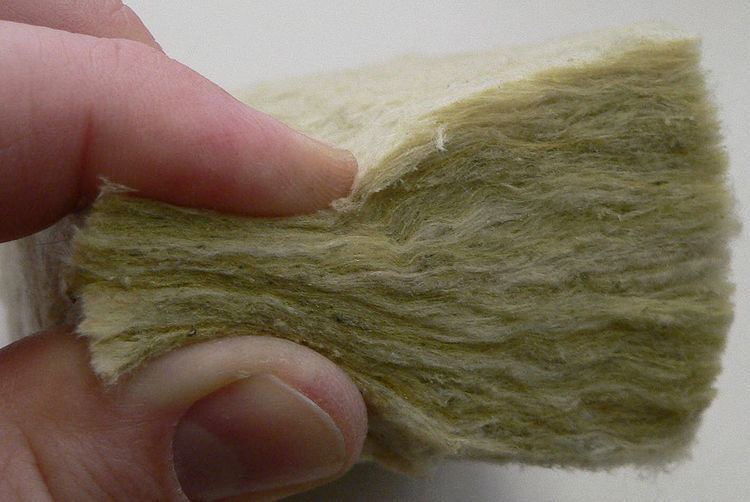 | ||
Mineral wool is a general name for fiber materials that are formed by spinning or drawing molten minerals (or "synthetic minerals" such as slag and ceramics).
Contents
Applications of mineral wool include thermal insulation (as both structural insulation and pipe insulation, though it is not as fire-resistant as high-temperature insulation wool), filtration, soundproofing, and hydroponic growth medium.
Naming
Mineral wool is also known as mineral fiber, mineral cotton, mineral fibre, man-made mineral fibre (MMMF), and man-made vitreous fiber (MMVF).
The nomenclature of these wool products is simply the parent/raw material name in prefix to "wool". Specific mineral wool products are stone wool and slag wool. Europe also includes glass wool which, together with ceramic fiber, are completely man-made fibers.
History
Slag wool was first made in 1840 in Wales by Edward Parry, "but no effort appears to have been made to confine the wool after production; consequently it floated about the works with the slightest breeze, and became so injurious to the men that the process had to be abandoned". A method of making mineral wool was patented in the United States in 1870 by John Player and first produced commercially in 1871 at Georgsmarienhütte in Osnabrück Germany. The process involved blowing a strong stream of air across a falling flow of liquid iron slag which was similar to the natural occurrence of fine strands of volcanic slag from Kilauea called Pele's hair created by strong winds blowing apart the slag during an eruption.
Manufacture
Stone wool is a furnace product of molten rock at a temperature of about 1600 °C, through which a stream of air or steam is blown. More advanced production techniques are based on spinning molten rock in high-speed spinning heads somewhat like the process used to produce cotton candy. The final product is a mass of fine, intertwined fibres with a typical diameter of 2 to 6 micrometers. Mineral wool may contain a binder, often a Ter-polymer, and an oil to reduce dusting.
Usage
Though the individual fibers conduct heat very well, when pressed into rolls and sheets, their ability to partition air makes them excellent insulators and sound absorbers. Though not immune to the effects of a sufficiently hot fire, the fire resistance of fiberglass, stone wool, and ceramic fibers makes them common building materials when passive fire protection is required, being used as spray fireproofing, in stud cavities in drywall assemblies and as packing materials in firestops.
Other uses are in resin bonded panels, as filler in compounds for gaskets, in brake pads, in plastics in the automotive industry, as a filtering medium, and as a growth medium in hydroponics.
Mineral fibers are produced in the same way, without binder. The fiber as such is used as a raw material for its reinforcing purposes in various applications, such as friction materials, gaskets, plastics, and coatings.
In hydroponics
Mineral wool products can be engineered to hold large quantities of water and air that aid root growth and nutrient uptake in hydroponics; their fibrous nature also provides a good mechanical structure to hold the plant stable. The naturally high pH of mineral wool makes them initially unsuitable to plant growth and requires "conditioning" to produce a wool with an appropriate, stable pH.
Safety of material
The International Agency for Research on Cancer (IARC) has reviewed the carcinogenicity of man-made mineral fibres in October 2002. The IARC Monograph's working group concluded only the more biopersistent materials remain classified by IARC as "possibly carcinogenic to humans" (Group 2B). These include refractory ceramic fibres, which are used industrially as insulation in high-temperature environments such as blast furnaces, and certain special-purpose glass wools not used as insulating materials. In contrast, the more commonly used vitreous fibre wools produced since 2000, including insulation glass wool, stone wool, and slag wool, are considered "not classifiable as to carcinogenicity in humans" (Group 3).
High biosoluble fibres are produced that do not cause damage to the human cell. These newer materials have been tested for carcinogenicity and most are found to be noncarcinogenic. IARC elected not to make an overall evaluation of the newly developed fibres designed to be less biopersistent such as the alkaline earth silicate or high-alumina, low-silica wools. This decision was made in part because no human data were available, although such fibres that have been tested appear to have low carcinogenic potential in experimental animals, and because the Working Group had difficulty in categorizing these fibres into meaningful groups based on chemical composition."
The European Regulation (CE) n° 1272/2008 on classification, labelling and packaging of substances and mixtures updated by the Regulation (CE) n°790/2009 does not classify mineral wool fibres as a dangerous substance if they fulfil criteria defined in its note Q.
The European Certification Board for mineral wool products, EUCEB, certify mineral wool products made of fibres fulfilling Note Q ensuring that they have a low biopersistence and so that they are fast removed from the lung. The certification is based on independent experts’ advice and regular control of the chemical composition www.euceb.org
Due to the mechanical effect of fibres, mineral wool products may cause temporary skin itching. To diminish this and to avoid unnecessary exposure to mineral wool dust, information on good practices is available on the packaging of mineral wool products with pictograms or sentences. Safe Use Instruction Sheets similar to Safety data sheet are also available from each producer.
People can be exposed to mineral wool fibers in the workplace by breathing them in, skin contact, and eye contact. The Occupational Safety and Health Administration (OSHA) has set the legal limit (permissible exposure limit) for mineral wool fiber exposure in the workplace as 15 mg/m3 total exposure and 5 mg/m3 respiratory exposure over an 8-hour workday. The National Institute for Occupational Safety and Health (NIOSH) has set a recommended exposure limit (REL) of 5 mg/m3 total exposure and 3 fibers per cm3 over an 8-hour workday.
